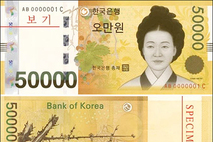
The highest-denomination banknote in South Korea is the 50,000-won bill, featuring Shin Saim dang as its design figure. It was first issued on June 23rd, 2009, in response to economic growth and in flation which highlighted the limitations of the 10,000-won note. The introduction of the 50,000 won bill aimed to reduce inconvenience in handling large cash transactions and inefficiency in high-value corporate exchanges. Since its release, it has been increasingly used, symbolizing practicality and effi ciency in daily life. The selection process for who would be featured on the 50,000-won billin

In November, Keimyung University cele brated its 125th anniversary by hosting an In ternational Student Traditional Costume Fashion Show at Keimyung Art Center. Organ ized by the International Affairs Center, the event aimed to promote cultural exchange through traditional attire from around the world. On November 13, 72 students from 29 coun tries, including Korea, Hungary, Japan, Egypt, and Ukraine, showcased their national cos tumes at the Keimyung Art Center. The event, attended by approximately 2,000 spectators, featured 35 traditional outfits, including Korea’s hanbok, Nepal’s Haku Patas

Q1: Could you tell us about the outfit you wore for the fashion show? What significance does it hold? I wore the Colombian traditional outfit called 'La Pollera Colora.' It consists of a brightly colored long skirt paired with a matching top. The skirt has a unique design that resembles a bird's wings when spread out, and it’s commonly used for performing the traditional Colombian dance, 'Cumbia.' The design allows the skirt to be used as part of the dance movements. The colors of the outfit can vary, often reflecting the Colombian flag or the flags of different regions. In my hometown, Barran